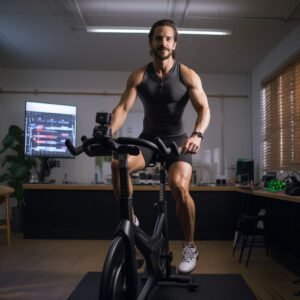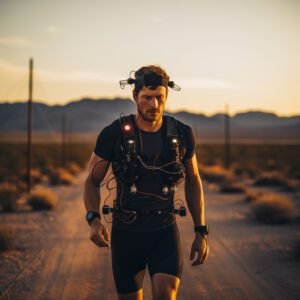
Biohacking Recovery Techniques for Optimal Health
Introduction
In our quest for optimal health and well-being, many of us are constantly exploring new strategies and techniques to enhance our physical and mental performance. One approach that has gained significant popularity in recent years is biohacking. Biohacking involves making conscious changes to our lifestyle, habits, and environment with the goal of optimizing our body and mind’s performance.
The concept of biohacking is centered around the idea that we can take control of our own biology and make deliberate choices to improve our health and overall quality of life. With an increasing interest in biohacking, more and more individuals are turning to recovery techniques that leverage this approach to enhance their healing process after injuries or strenuous activities.
In this blog post, we will explore some key concepts of biohacking recovery techniques and provide practical tips that you can incorporate into your daily routine to support your body’s recovery process.
Key Concepts of Biohacking Recovery Techniques
When it comes to biohacking recovery, there are several key concepts worth exploring. Here are a few areas that biohackers often focus on:
1. Nutrition
Proper nutrition is essential for optimal recovery. Biohackers often prioritize nutrient-dense foods that support tissue repair and reduce inflammation. Incorporating anti-inflammatory foods like fatty fish, leafy greens, and berries into your diet can help promote healing and reduce recovery time.
2. Sleep Optimization
Quality sleep is crucial for repairing and rejuvenating the body. Biohackers employ various strategies to enhance their sleep quality, such as maintaining a regular sleep schedule, creating a sleep-friendly environment, and practicing relaxation techniques before bed. Investing in a high-quality mattress or utilizing sleep tracking technologies can also provide valuable insights for optimizing restorative sleep.
3. Exercise
While it may seem counterintuitive, engaging in proper exercise can aid in recovery. Biohackers emphasize targeted and controlled exercise routines designed to stimulate circulation, promote tissue repair, and strengthen the body. This can include activities like low-impact cardio, resistance training, and stretching.
4. Stress Management
Chronic stress can hinder recovery and compromise overall health. Biohacking recovery techniques often involve stress management strategies like meditation, deep breathing exercises, and mindfulness practices. These techniques help activate the body’s relaxation response, reduce stress hormones, and promote a state of balance conducive to healing.
5. Technology in Biohacking
Advancements in technology have opened up new possibilities for biohackers. From wearable devices that track vital signs to apps that monitor sleep patterns, technology is increasingly playing a role in biohacking recovery. Utilizing these tools can provide valuable data and insights to optimize recovery and make informed decisions about your health.
Practical Biohacking Tips
Now that we have established the key concepts, let’s explore some practical biohacking tips that you can implement to support your recovery journey:
- Fuel your body with nutrient-dense foods: Incorporate a variety of colorful fruits and vegetables, healthy fats, and lean proteins into your diet to provide essential nutrients for healing.
Prioritize sleep: Create a consistent sleep schedule, optimize your sleep environment (dark, quiet, and cool), and establish a relaxing bedtime routine to promote quality sleep.
Engage in targeted exercise: Work with a qualified professional to develop a customized exercise routine that supports your specific recovery needs, incorporating both strength and mobility exercises.
Practice stress-reducing techniques: Incorporate mindfulness meditation, deep breathing exercises, or yoga into your daily routine to manage stress and promote relaxation.
Leverage technology: Utilize wearable devices, smartphone apps, or even biofeedback devices to track your progress, measure vital signs, and gain insights into your recovery journey.
Remember, it is important to listen to your body and consult with healthcare professionals to ensure that these techniques align with your specific needs and medical history.
Biohacking FAQs
Question 1: Can biohacking techniques help accelerate the recovery process?
– Answer: Biohacking techniques can certainly support and optimize the recovery process by providing the body and mind with the necessary tools and environment for healing. However, it is important to note that the rate of recovery can vary depending on the individual and the nature of the injury or condition.
Question 2: How long does it take to see results from biohacking recovery techniques?
– Answer: The timeline for experiencing results from biohacking recovery techniques can vary. Some individuals may notice improvements in their overall well-being and recovery time within a few weeks, while others may take longer. Consistency, adherence to recommended practices, and individual factors all play a role in determining the timeline for results.
Question 3: Are there any risks associated with biohacking recovery techniques?
– Answer: While biohacking recovery techniques are generally safe, it is important to approach them with caution and seek guidance from qualified professionals. Every individual is unique, and certain practices may not be suitable for everyone. It is crucial to listen to your body, consult healthcare professionals, and make informed decisions about your health.
Question 4: Can biohacking recovery techniques be used in conjunction with traditional medical treatments?
– Answer: Absolutely! Biohacking recovery techniques can complement traditional medical treatments. It is important to work in collaboration with healthcare professionals and follow their guidance to ensure a holistic and well-rounded approach to recovery.
Question 5: Is biohacking limited to physical recovery, or can it help with mental and emotional recovery as well?
– Answer: Biohacking techniques can be beneficial for mental and emotional recovery as well. Practices such as mindfulness meditation, stress reduction, and optimizing sleep can have positive effects on mental well-being and emotional balance.
Conclusion
Biohacking recovery techniques offer a personalized and proactive approach to optimize the recovery process. By incorporating principles of nutrition, sleep optimization, exercise, stress management, and leveraging technology, individuals can enhance their healing journey and promote overall well-being. However, it is essential to approach biohacking with an informed mindset and seek guidance from healthcare professionals. Remember, individual needs and medical history play crucial roles in determining the most effective strategies for your recovery. Explore the world of biohacking, experiment with techniques that resonate with you, and embark on a journey towards optimal health and vitality.
Disclaimer: The information provided in this blog post is for informational purposes only and should not be considered medical advice. Always consult with a healthcare professional before making any significant changes to your lifestyle or treatment plan.


